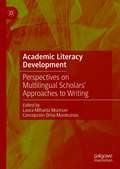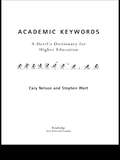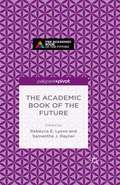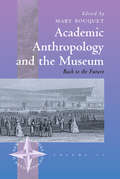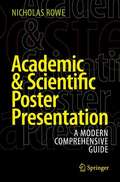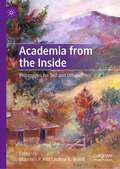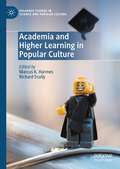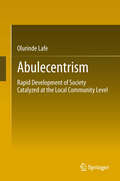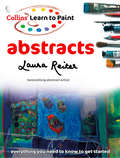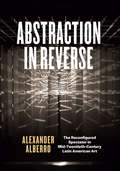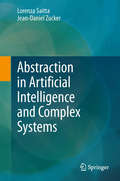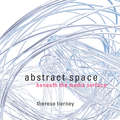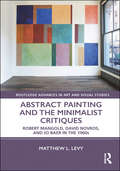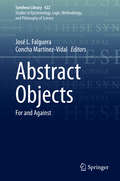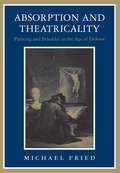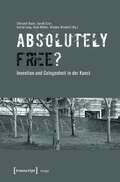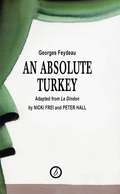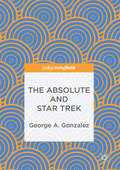- Table View
- List View
Academic Literacy Development: Perspectives on Multilingual Scholars' Approaches to Writing
by Laura-Mihaela Muresan Concepción Orna-MontesinosThis edited book brings together an international cast of contributors to examine how academic literacy is learned and mastered in different tertiary education settings around the world. Bringing to the fore the value of qualitative enquiry through ethnographic methods, the authors illustrate in-depth descriptions of genre knowledge and academic literacy development in first and second language writing. All of the data presented in the chapters are original, as well as innovative in the field in terms of content and scope, and thought-provoking regarding theoretical, methodological and educational approaches. The contributions are also representative of both novice and advanced academic writing experiences, providing further insights into different stages of academic literacy development throughout the career-span of a researcher. Set against the backdrop of internationalisation trends in Higher Education and the pressure on multilingual academics to publish their research outcomes in English, this volume will be of use to academics and practitioners interested in the fields of Languages for Academic Purposes, Applied Linguistics, Literacy Skills, Genre Analysis and Acquisition and Language Education.
Academic Keywords: A Devil's Dictionary for Higher Education
by Cary Nelson Stephen WattKnow what academic freedom is? Or what it's come to mean? What's affirmative about affirmative action these days? Think you're up on the problem of sexual harassment on campus? Or know how much the university depends on part-time faculty? Academic Keywords is a witty, informed, and sometimes merciless assessment of today's campus, an increasingly corporatized institution that may have bitten off more than its administration is ready to chew. Cary Nelson and Steve Watt use the format of a dictionary to present stories and reflections on some of the most pressing issues affecting higher education in America. From the haphazard treatment of graduate students to the use and abuse of faculty (as well as abuses commited by faculty), Nelson and Watt present a compelling and, at times, enraging report on the state of the campus.
Academic Keywords: A Devil's Dictionary for Higher Education
by Cary Nelson Stephen WattKnow what academic freedom is? Or what it's come to mean? What's affirmative about affirmative action these days? Think you're up on the problem of sexual harassment on campus? Or know how much the university depends on part-time faculty? Academic Keywords is a witty, informed, and sometimes merciless assessment of today's campus, an increasingly corporatized institution that may have bitten off more than its administration is ready to chew. Cary Nelson and Steve Watt use the format of a dictionary to present stories and reflections on some of the most pressing issues affecting higher education in America. From the haphazard treatment of graduate students to the use and abuse of faculty (as well as abuses commited by faculty), Nelson and Watt present a compelling and, at times, enraging report on the state of the campus.
The Academic Book of the Future
by Rebecca E. Lyons Samantha J. RaynerThis book is open access under a CC-BY licence. Part of the AHRC/British Library Academic Book of the Future Project, this book interrogates current and emerging contexts of academic books from the perspectives of thirteen expert voices from the connected communities of publishing, academia, libraries, and bookselling.
Academic Anthropology and the Museum: Back to the Future (New Directions in Anthropology #13)
by Mary BouquetThe museum boom, with its accompanying objectification and politicization of culture, finds its counterpart in the growing interest by social scientists in material culture, much of which is to be found in museums. Not surprisingly, anthropologists in particular are turning their attention again to museums, after decades of neglect, during which fieldwork became the hallmark of modern anthropology - so much so that the "social" and the "material" parted company so radically as to produce a kind of knowledge gap between historical collections and the intellectuals who might have benefitted from working on these material representations of culture. Moreover it was forgotten that museums do not only present the "pastness" of things. A great deal of what goes on in contemporary museums is literally about planning the shape of the future: making culture materialize involves mixing things from the past, taking into account current visions, and knowing that the scenes constructed will shape the perspectives of future generations. However, the (re-)invention of museum anthropology presents a series of challenges for academic teaching and research, as well as for the work of cultural production in contemporary museums - issues that are explored in this volume.
Academic And Scientific Poster Presentation: A Modern Comprehensive Guide (PDF)
by Nicholas RoweThis book offers the first comprehensive guide to poster presentation at academic, scientific and professional conferences. Each chapter explores different factors that impact upon how posters function, and how they fit within today's conference practices, as well as provides guidance on how to address compilation and presentation issues with the poster medium. Drawing from fields of education, psychology, advertising and other areas, the book offers examples of how theories may be applied to practice in terms of both traditional paper and electronic poster formats. Importantly, the book offers a critical examination of how academic and scientific posters are able to achieve their potential for knowledge dissemination, networking and knowledge transfer. The many new and challenging findings provide an evidence-based approach to help both novice and experienced presenters compile effective poster presentations, and to see how poster presentations can best be used to share knowledge, facilitate networking, and promote dialogue. Additionally, educators, employers, and conference organizers may use this book to re-evaluate how conferences meet the needs of today's globally connected peer groups, and the benefit they provide at individual and group levels.
Academic And Scientific Poster Presentation: A Modern Comprehensive Guide
by Nicholas RoweThis book offers the first comprehensive guide to poster presentation at academic, scientific and professional conferences. Each chapter explores different factors that impact upon how posters function, and how they fit within today's conference practices, as well as provides guidance on how to address compilation and presentation issues with the poster medium. Drawing from fields of education, psychology, advertising and other areas, the book offers examples of how theories may be applied to practice in terms of both traditional paper and electronic poster formats. Importantly, the book offers a critical examination of how academic and scientific posters are able to achieve their potential for knowledge dissemination, networking and knowledge transfer. The many new and challenging findings provide an evidence-based approach to help both novice and experienced presenters compile effective poster presentations, and to see how poster presentations can best be used to share knowledge, facilitate networking, and promote dialogue. Additionally, educators, employers, and conference organizers may use this book to re-evaluate how conferences meet the needs of today's globally connected peer groups, and the benefit they provide at individual and group levels.
Academia from the Inside: Pedagogies for Self and Other
by Maureen P. Hall Aubrie K. BraultThis book invites readers to explore how fourteen different experts in their respective fields create deeper meaning in their profession and work with students through thinking, in multiple ways, about the self who teaches, the self who learns, and the ways in which these selves interact within the academy. Essays in this book explore the “inside” of academia through three themes: Pursuing Authenticity, Creating Creative Community, and Humanizing Education. Contributors reflect on their own lived experiences in the academy and on pedagogies that they have created for their students. Embodied education, the theoretical framework of this book, draws on ideas of educators Parker Palmer from the West and Dr. Chinmay Pandya from the East, emerging through contributors’ collaborative work. In embodied education, teachers and learners share experiences that lead to self-understanding and together find ways to humanize spaces in academia.
Academia and Higher Learning in Popular Culture (Palgrave Studies in Science and Popular Culture)
by Marcus K. Harmes Richard ScullyThis edited volume focuses on the cultural production of knowledge in the academy as mediated or presented through film and television. This focus invites scrutiny of how the academy itself is viewed in popular culture from The Chair to Terry Pratchett's ‘Unseen University’ and Doctor Who's Time Lord Academy among others. Spanning a number of genres and key film and television series, the volume is also inherently interdisciplinary with perspectives from History, Cultural Studies, Gender Studies, STEM, and more. This collection brings together leading experts in different disciplines and from different national backgrounds. It emphasises that even at a point of mass, global participation in higher education, the academy is still largely mediated by popular culture and understood through the tropes perpetuated via a multimedia landscape.
Abulecentrism: Rapid Development of Society Catalyzed at the Local Community Level
by Olurinde LafeThe book describes a development concept called abulecentrism. The Yoruba word abule (pronounced: a-boo-lay) literarily means “the village”. abulecentrism seeks to achieve rapid and sustainable development of a given society by the strategic execution of projects and the provision of critical services at the local community level. The village has always been the traditional unit of communal living in many societies around the world. The typical village is small, comprising close-knit social groups and individuals that number in the tens, or at most, low hundreds. In a village, people live close to one another, and derive strength in their communal methods of living, working and protecting their society. Furthermore, the management and governance of the community is simpler than in urban areas because the village requires smaller administrative systems. abulecentrism is built on the philosophy of using small, modular systems, such as a village, as building blocks for developing the greater society. The ultimate goal of abulecentrism is for the larger society to be significantly impacted by the dividends of the aggregated development attained within the different communities. Development projects will typically be executed by starting with a few local communities and progressing organically until all the communities that make up the larger society have been impacted.
Abstracts (Collins Learn to Paint)
by Laura ReiterLearn to Paint Abstracts forms part of the best-selling Collins Learn to Paint series, providing a clear and simple introduction to a truly dynamic style of painting that is attracting more and more interest among amateur artists.
Abstraction in Reverse: The Reconfigured Spectator in Mid-Twentieth-Century Latin American Art
by Alexander AlberroDuring the mid-twentieth century, Latin American artists working in several different cities radically altered the nature of modern art. Reimagining the relationship of art to its public, these artists granted the spectator an unprecedented role in the realization of the artwork. The first book to explore this phenomenon on an international scale, Abstraction in Reverse traces the movement as it evolved across South America and parts of Europe. Alexander Alberro demonstrates that artists such as Tomás Maldonado, Jesús Soto, Julio Le Parc, and Lygia Clark, in breaking with the core tenets of the form of abstract art known as Concrete art, redefined the role of both the artist and the spectator. Instead of manufacturing autonomous art, these artists produced artworks that required the presence of the spectator to be complete. Alberro also shows the various ways these artists strategically demoted regionalism in favor of a new modernist voice that transcended the traditions of the nation-state and contributed to a nascent globalization of the art world.
Abstraction in Reverse: The Reconfigured Spectator in Mid-Twentieth-Century Latin American Art
by Alexander AlberroDuring the mid-twentieth century, Latin American artists working in several different cities radically altered the nature of modern art. Reimagining the relationship of art to its public, these artists granted the spectator an unprecedented role in the realization of the artwork. The first book to explore this phenomenon on an international scale, Abstraction in Reverse traces the movement as it evolved across South America and parts of Europe. Alexander Alberro demonstrates that artists such as Tomás Maldonado, Jesús Soto, Julio Le Parc, and Lygia Clark, in breaking with the core tenets of the form of abstract art known as Concrete art, redefined the role of both the artist and the spectator. Instead of manufacturing autonomous art, these artists produced artworks that required the presence of the spectator to be complete. Alberro also shows the various ways these artists strategically demoted regionalism in favor of a new modernist voice that transcended the traditions of the nation-state and contributed to a nascent globalization of the art world.
Abstraction in Reverse: The Reconfigured Spectator in Mid-Twentieth-Century Latin American Art
by Alexander AlberroDuring the mid-twentieth century, Latin American artists working in several different cities radically altered the nature of modern art. Reimagining the relationship of art to its public, these artists granted the spectator an unprecedented role in the realization of the artwork. The first book to explore this phenomenon on an international scale, Abstraction in Reverse traces the movement as it evolved across South America and parts of Europe. Alexander Alberro demonstrates that artists such as Tomás Maldonado, Jesús Soto, Julio Le Parc, and Lygia Clark, in breaking with the core tenets of the form of abstract art known as Concrete art, redefined the role of both the artist and the spectator. Instead of manufacturing autonomous art, these artists produced artworks that required the presence of the spectator to be complete. Alberro also shows the various ways these artists strategically demoted regionalism in favor of a new modernist voice that transcended the traditions of the nation-state and contributed to a nascent globalization of the art world.
Abstraction in Reverse: The Reconfigured Spectator in Mid-Twentieth-Century Latin American Art
by Alexander AlberroDuring the mid-twentieth century, Latin American artists working in several different cities radically altered the nature of modern art. Reimagining the relationship of art to its public, these artists granted the spectator an unprecedented role in the realization of the artwork. The first book to explore this phenomenon on an international scale, Abstraction in Reverse traces the movement as it evolved across South America and parts of Europe. Alexander Alberro demonstrates that artists such as Tomás Maldonado, Jesús Soto, Julio Le Parc, and Lygia Clark, in breaking with the core tenets of the form of abstract art known as Concrete art, redefined the role of both the artist and the spectator. Instead of manufacturing autonomous art, these artists produced artworks that required the presence of the spectator to be complete. Alberro also shows the various ways these artists strategically demoted regionalism in favor of a new modernist voice that transcended the traditions of the nation-state and contributed to a nascent globalization of the art world.
Abstraction in Artificial Intelligence and Complex Systems
by Lorenza Saitta Jean-Daniel ZuckerAbstraction is a fundamental mechanism underlying both human and artificial perception, representation of knowledge, reasoning and learning. This mechanism plays a crucial role in many disciplines, notably Computer Programming, Natural and Artificial Vision, Complex Systems, Artificial Intelligence and Machine Learning, Art, and Cognitive Sciences. This book first provides the reader with an overview of the notions of abstraction proposed in various disciplines by comparing both commonalities and differences. After discussing the characterizing properties of abstraction, a formal model, the KRA model, is presented to capture them. This model makes the notion of abstraction easily applicable by means of the introduction of a set of abstraction operators and abstraction patterns, reusable across different domains and applications. It is the impact of abstraction in Artificial Intelligence, Complex Systems and Machine Learning which creates the core of the book. A general framework, based on the KRA model, is presented, and its pragmatic power is illustrated with three case studies: Model-based diagnosis, Cartographic Generalization, and learning Hierarchical Hidden Markov Models.
Abstract Space: Beneath the Media Surface
by Therese TierneyThis visually stunning, conceptually rich and imaginative book investigates the cultural connection between new media and architectural imaging. Through a range of material, from theoretical texts to experimental design projects, Tierney explores notions of what the architectural image means today. Within the book's visually imaginative design framework, Abstract Space engages discourses from architecture, visual and cultural studies to computer science and communications technology to present an in-depth multi-media case study. Tracing a provisional history of the topic, the book also lends a provocative and multivalent understanding to the complex relations affecting the architectural image today.
Abstract Space: Beneath the Media Surface
by Therese TierneyThis visually stunning, conceptually rich and imaginative book investigates the cultural connection between new media and architectural imaging. Through a range of material, from theoretical texts to experimental design projects, Tierney explores notions of what the architectural image means today. Within the book's visually imaginative design framework, Abstract Space engages discourses from architecture, visual and cultural studies to computer science and communications technology to present an in-depth multi-media case study. Tracing a provisional history of the topic, the book also lends a provocative and multivalent understanding to the complex relations affecting the architectural image today.
Abstract Painting and the Minimalist Critiques: Robert Mangold, David Novros, and Jo Baer in the 1960s (Routledge Advances in Art and Visual Studies)
by Matthew L. LevyThis book undertakes a critical reappraisal of Minimalism through an examination of three key painters: Robert Mangold, David Novros, and Jo Baer. By establishing their substantive engagements with Minimalist discourse, as well as their often overlooked artistic exchanges with their sculptor peers, it demonstrates that painting crucially informed the movement’s development, serving not only as an object of critique but also as a crucible for its most central tenets. It also poses broader disciplinary implications as it historicizes and challenges Minimalism’s "death of painting" critiques that have been so influential to theories of modernism and postmodernism in the visual arts.
Abstract Painting and the Minimalist Critiques: Robert Mangold, David Novros, and Jo Baer in the 1960s (Routledge Advances in Art and Visual Studies)
by Matthew L. LevyThis book undertakes a critical reappraisal of Minimalism through an examination of three key painters: Robert Mangold, David Novros, and Jo Baer. By establishing their substantive engagements with Minimalist discourse, as well as their often overlooked artistic exchanges with their sculptor peers, it demonstrates that painting crucially informed the movement’s development, serving not only as an object of critique but also as a crucible for its most central tenets. It also poses broader disciplinary implications as it historicizes and challenges Minimalism’s "death of painting" critiques that have been so influential to theories of modernism and postmodernism in the visual arts.
Abstract Objects: For and Against (Synthese Library #422)
by José L. Falguera Concha Martínez-VidalThis volume examines the question “Do abstract objects exist?”, presenting new work from contributing authors across different branches of philosophy. The introduction overviews philosophical debate which considers: what objects qualify as abstract, what do we mean by the word "exist” and indeed, what evidence should count in favor or against the thesis that abstract objects exist. Through subsequent chapters readers will discover the ubiquity of abstract objects as each philosophical field is considered.Given the ubiquitous use of expressions that purportedly refer to abstract objects, we think that it is relevant to attend to the controversy between those who want to advocate the existence of abstract objects and those who stand against them. Contributions to this volume depict positions and debates that directly or indirectly involve taking one position or other about abstract objects of different kinds and categories. The volume provides a variety of samples of how positions for or against abstract objects can be used in different areas of philosophy in relation to different matters.
Absorption and Theatricality: Painting and Beholder in the Age of Diderot
by Michael FriedWith this widely acclaimed work, Fried revised the way in which eighteenth-century French painting and criticism were viewed and understood. "A reinterpretation supported by immense learning and by a series of brilliantly perceptive readings of paintings and criticism alike. . . . An exhilarating book."—John Barrell, London Review of Books
»Absolutely Free«? - Invention und Gelegenheit in der Kunst (Image #163)
by Christof Baier Sarah Czirr Astrid Lang Gina Möller Wiebke WindorfUnter der Fragestellung »Absolutely Free«? ist die Jubiläumsschrift für den Kunsthistoriker Jürgen Wiener aus interdisziplinärer Perspektive der Produktion, Rezeption, Gestaltung und Wahrnehmung von Kunst gewidmet. Die Spanne der Aufsätze reicht von der Einheit und Vielfalt in der karolingischen Kunst über Spitzwegs Bildformate bis zur Konstruktion von (Kunst-)Geschichte bei Damien Hirst, von mittelalterlichen Stickereien über Berninis Tierdarstellungen am Vierströmebrunnen bis zu einem Plädoyer für Polyrhythmik in der zeitgenössischen Geschichtsschreibung nach dem Vorbild Frank Zappas. Mit Beiträgen von Vittoria Borsò, Gertrude Cepl-Kaufmann, Dietrich Erben, Joachim Poeschke u.v.a.
An Absolute Turkey (Oberon Classics)
by Peter Hall Georges Feydeau Nicki FreiGeorges Feydeau (1862-1921), the supreme master of farce, devoted his skills to exploding hypocrisy in a very self-important age. An Absolute Turkey (Le Dindon) is one of his best loved plays. He displays all his dramatic tricks as the characters are pulled back and forth by an escalating series of complications. This translation received its London premiere at the Globe Theatre in January 1994.
The Absolute and Star Trek
by George A. GonzalezThis volume explains how Star Trek allows viewers to comprehend significant aspects of Georg Hegel’s concept the absolute, the driving force behind history.Gonzalez, with wit and wisdom, explains how Star Trek exhibits central elements of the absolute. He describes how themes and ethos central to the show display the concept beautifully. For instance, the show posits that people must possess the correct attitudes in order to bring about an ideal society: a commitment to social justice; an unyielding commitment to the truth; and a similar commitment to scientific, intellectual discovery. These characteristics serve as perfect embodiments of Hegel’s conceptualization, and Gonzalez's analysis is sharp and exacting.
